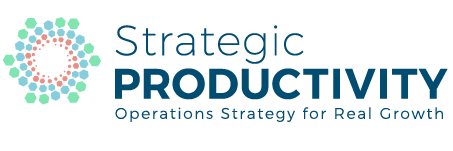
Every organization has Operations. The best use Strategic Productivity to recast their Operations to produce a cycle of increasing revenue, improving margins, and more engaged, innovative, and productive employees—in other words, real, sustainable growth.
Operations always directly impacts the revenue and growth of a business.
Operations is everything involved in transforming raw materials and/or information into the finished products or services intended to meet a customer’s need—their “job to be done”—and transact an exchange of value with the customer in return.
Every plan, every intention an organization has to meet a customer need (and receive an exchange of value in return for it) must unavoidably filter through the organization’s Operations. That’s the inescapable role Operations always plays! It always directly impacts—for good or for bad—the revenue and growth of a business.
Operations is core to organizations of all sizes and stages, across all industries:
Manufacturing
Software
Energy
Technology
e-commerce
Service
Retail
Finance
Automation
Healthcare
Big data/analytics
Transportation
Product design
Supply chain
Government
Hospitality
Education
Culture/HR
Concept stage
Start-ups
Early stage
Growth companies
Mature/established
Global enterprises
Operations is the true heart and headwaters for culture and employee engagement.
Everyone who’s worked has experienced the malady of disengaging, discouraging, and disappointing work. 80 percent of workers say they aren’t engaged in their work and that their company doesn’t want or need their best efforts.
Companies try remedies through popular HR, wellness, cultural, and facility/campus programs. But these efforts are consigned to the margins. Operations, where and how work is actually done, is the true heart and headwaters for culture and employee engagement.
Getting Operations right engages employees for real, leading naturally to motivation, innovation and a cycle of renewed learning and productivity.
Strategic Productivity is recognizing the inescapable role and impact of operations in all industries and aspects of work, then recasting operations—how work is done—to efficiently delivering more and more value to customers while showing greater and greater respect to employees.
The result of Strategic Productivity is a cycle of increased revenue, improved margins, and more engaged/innovative/productive employees—i.e., Real Growth.
It’s embodied in a specific management metric that elevates and guides all company decisions, from the boardroom to the factory floor.
When tracked, it gives an immediate and far-superior indicator of present company trajectory and future company success.

The prevailing management metric and emphasis for Operations compares the output produced to the associated input costs required. For example, see the Business Dictionary’s definition of Productivity.. But when leaders use any classic, efficiency-based approach to measure or direct their Operations, they always unwittingly disconnect their Operations from real growth and relegate their company to a cycle of degraded performance and disengaged employees.
Strategic Productivity, instead, measures Operations through its actual productivity. It compares the net customer value delivered to the associated input costs.
How to design, decide, and carry out work:
Be in it for the long haul
Prioritize delivering long-term customer value over gaining short-term business advantage.
Respect people
Challenge and enable them to continually improve their productivity and the conditions under which they work.
Learn continuously
Be curious not judgmental, and never protect the status quo.




